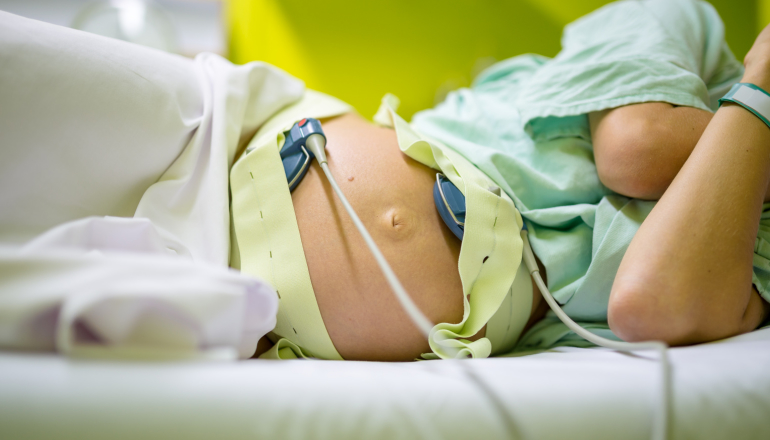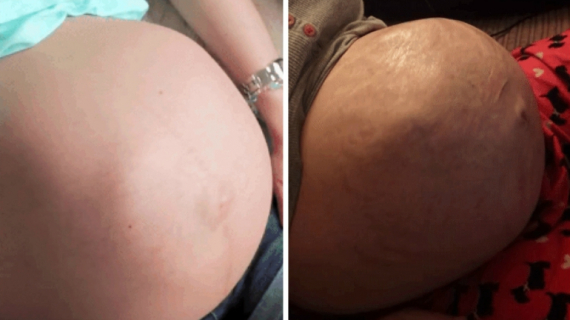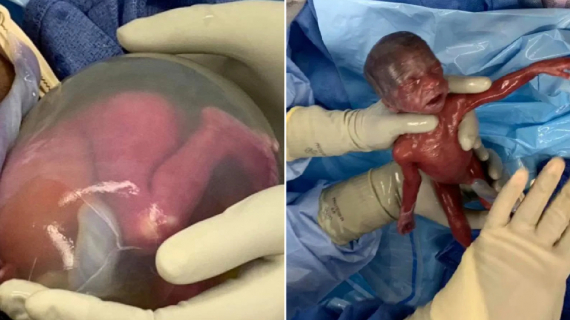Vaginal Birth Recovery: Top 10 Answers You Need To Know

1) How long will I bleed?
Blood flow can last for up to 6 weeks after baby’s birth but for most women, it will subside sooner.
– For the first few days after baby’s birth, your blood flow will be bright red and about as heavy as your menstrual period. You may notice a small gush when you stand up after sitting or lying down. Although this may seem alarming, it can be normal. The blood can pool in your vagina while you relax. When you suddenly change position, it comes out in a ‘gush’. If you have flow so heavy that you completely soak a maxi pad, from front to back, in less than an hour, you need to seek medical attention.
– By the time baby is three or four days old, your blood flow should start to become more watery and pinkish in color.
– By 8-10 days after delivery, your blood flow should be mostly yellowish-white in color.
If your flow had subsided but it becomes bright red and heavy again, it could be your body’s way of telling you that you are overdoing it. Try resting to see if it subsides. Bleeding that stays bright red past the first week is unusual; see your healthcare provider.
2) Are blood clots normal?
Occasional small blood clots are normal. By “small”, we mean clots the size of a $1.00 Canadian coin or smaller. Blood clots are dark red in color and appear jelly-like. After passing a clot, it is important to watch your blood flow carefully for the next hour. If you should completely soak a maxi pad, from front to back, in less than an hour, seek medical attention immediately (go to the closest emergency room).
It is rare, but a piece of the placenta can be left behind in your uterus after you give birth. When you pass this tissue, it will appear whitish and stringy. Monitor your symptoms a little more closely with this type of clot, as you are more at risk to develop heavy bleeding and infection.
3) How do I take care of my stitches?
Keep them clean: Not all women get stitches after a vaginal birth but if you do, you will need to keep them clean to prevent infection. Use a squirt bottle filled with warm water to clean your bottom after using the washroom. If your stitches sting when you pee, try squirting water as you pee to see if that removes the sting. Drink enough water to keep your urine dilute, as it will then burn less. Your urine should be colorless and not yellow!
Decrease swelling: If your bottom is swollen, using an ice pack during the first 24 hours can be helpful. Some women put water on a sanitary pad and freeze it to use as an ice pack.
Soak your stitches: Soak your stitches in a tub of warm bath water 2 or 3 times a day. This helps to keep the stitches clean and brings blood to the area to speed healing. Some women find air-drying helpful. To air dry, lay on the bed with nothing on your bottom for a few minutes or use a hairdryer on the low setting.
Sit on a ‘donut’: If your stitches are painful, try sitting on an inflatable ring (available at most drug stores) or a homemade ‘donut’ (towel rolled up and made into a ring). This helps to take the pressure off your bottom when you sit.
Stitches are dissolvable: Most stitches take up to 3 weeks to heal and will dissolve on their own. If you lose a stitch prematurely, doctors will not re-suture the area. Continue to keep the area clean and air dry to promote healing.
4) Can I take something for pain?
After a vaginal birth, you may have 3 types of pain: pain from an episiotomy or tear, ‘afterpains’ or hemorrhoid pain. Or, you may be lucky enough to have none of these!
Episiotomies and tears: Some tears are quite small and will cause little discomfort. Extensive tears or episiotomies take longer to heal. Tub soaks (as mentioned in #3) help to decrease perineal pain. You may need to take pain medication regularly for the first few days. Most pain medications are compatible with breastfeeding. Ask your healthcare provider for instructions.
Afterpains: You may feel labour-like cramping as your uterus shrinks to its pre-pregnancy size. These cramps are strongest in the first few days after childbirth and should subside a little each day. When you breastfeed, the hormone that releases your milk also causes your uterus to cramp. Although it is uncomfortable, it helps to keep your bleeding under control. Taking regular pain medication can help to stay on top of this pain. If you wait until you experience an afterpain to take medication, the afterpain will be gone before the medication can take effect.
Hemorrhoids: Hemorrhoids can begin during your pregnancy or appear after delivery. Tub soaks may be soothing. Over the counter ointments and creams will help to shrink the hemorrhoid and relieve the pain. If your hemorrhoids are severe, you may need a prescription ointment. Taking oral pain medications regularly can also be helpful.
5) Will it hurt to have a bowel movement? Will my stitches let go?
Women are often scared to have their first bowel movement after giving birth, worrying they will split their stitches open. This trick can help: Using a clean pad, apply gentle counter pressure over your stitches as you push. This can help you to relax enough to pass that first stool.
Drink lots of fluids and eat high fiber foods (such as bran, raw fruits and vegetables) to keep your bowel movements soft. Sometimes, a mild stool softener such as Docusate Sodium is suggested for the first week.
6) When will my milk come in?
You have milk as soon as your baby is born! The first milk is called colostrum. It is a thick yellowish fluid and is produced in small volumes, perfect for the small size of your baby’s tummy. Colostrum is full of antibodies and properties that are important for your baby’s health.
Around the third day after birth, you will notice your breasts becoming heavier. This signals a change to the more mature type of milk. The color changes from a golden to a whitish color and larger volumes will be produced.
7) Do I need a special diet when breastfeeding?
There is no need to worry about a special diet when breastfeeding. A healthy diet is all that is needed.
You may hear well-meaning advice from family or friends about avoiding gassy foods such a beans or cabbage etc. This is an old wives tale. Gas from the mother’s intestinal tract cannot be passed into her breast milk. The foods we eat can flavor breast milk but this doesn’t harm the baby; it is thought to be an early introduction to flavors.
An exception to this can be cow’s milk protein found in dairy products. It is rare (only 2-7% of babies), but some babies may be allergic to dairy and react to it in the mother’s diet.
It is recommended to limit your intake of caffeine to no more than 1 or 2 cups a day. Excessive caffeine may make baby fussy.
8) Why am I feeling so emotional?
Women feel emotional after the birth of a baby! Sometimes the emotions may be those you were expecting: euphoria, instant love. Other times, the emotions may not be expected. Many women report feeling a dull, flat disappointed feeling after birth. Others are embarrassed to admit they feel nothing for their baby.
Having a baby can be a very overwhelming experience. There is no right or wrong way to feel. A difficult delivery, or one that didn’t go as you envisioned, may make it worse. Talk to your loved ones or your health care provider about the way you are feeling. Please know that even if you feel disconnected from your baby, feelings of connectedness will come in time. Taking time to rest and care for yourself is important.
Looking after a newborn is more than a full time job. Coupled with the lack of time to sleep, it is no wonder this is a high-risk time for the flare-up of anxiety and depression.
Postpartum blues are common in the first few weeks. If these feelings do not resolve in the first few weeks or the symptoms worsen, you could be suffering from postpartum depression and may benefit from treatment and a support group. Please talk to your healthcare provider.
9) How will I know if I have an infection?
The most common places to develop an infection after a vaginal birth are your stitches, your uterus and your bladder.
Stitches: The first sign of an infection is increasing pain in your stitches, despite taking the same amount of pain medication. Reddened skin around the stitches or a thick yellow or greenish discharge is also signs to watch for.
Uterus: A foul or rotten odour to your vaginal blood flow can be a sign of an infection in the uterus. (Note: If you are unsure if your flow smells foul, it probably isn’t!) A smell similar to your regular menstrual flow is normal.
Bladder: Symptoms of a bladder infection include burning when you pee, having to pee frequently and a feeling of ‘urgency’ (needing to use the washroom NOW!). Remember, it is not unusual to feel some burning around the stitches when you pee (see point #3).
General: If you should develop a fever in the first 6 weeks after giving birth, please notify your healthcare provider. You may have developed an infection that will require treatment.
10) When can I have sex again?
Let’s face it; it is not the new moms who are asking this question! It is, however, high on the new dad’s list of questions. The general recommendation is to wait 6 weeks after before resuming sexual intercourse. There are a few reasons why.
The first is an increased risk of infection. Your uterus needs to heal at the site where the placenta was attached. This area is susceptible to infection if bacteria is introduced during intercourse. Secondly, it may take 6 weeks for the stitches to fully heal and become less tender.














